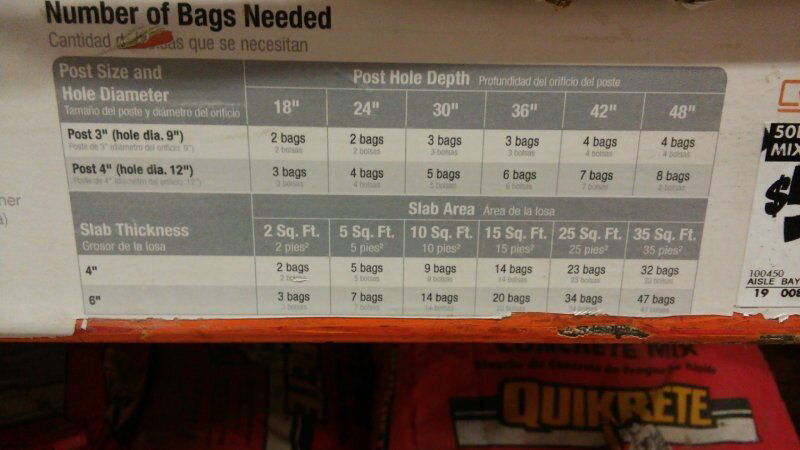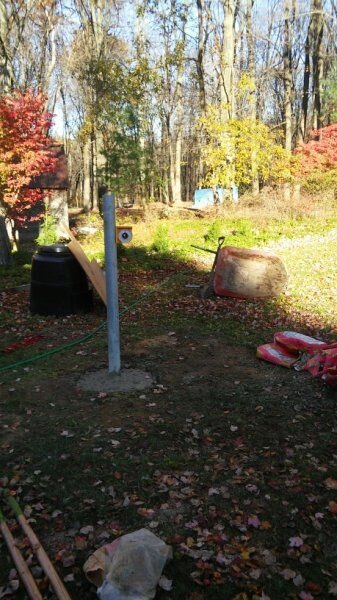I think how much cement you use in a hole is a bit like a discussion of religion or politics - everybody's got an opinion, and some will defend theirs to the death. I have always used a minimal approach, which means I use a old-time post hole digger that digs a hole maybe 4 to 5 feet deep and maybe 8 to 10 inches across at the top, I've never actually measured it. I've dropped my pole in that, and used between three and five bags of concrete mix to fill it. And I have never drilled holes in the pole or welded anything to it. So far have never had a problem. I do it this way for a few reasons:
- I don't live in an area where we get hurricanes. And I wouldn't, but if I did I'd definitely go wider and use more concrete.
- I don't have a welder and don't know anyone who does, and I'm too lazy to drill holes through solid metal.
- Where I live there are tree roots EVERYWHERE, even if there are no trees currently close to the dish. So again, laziness prevents me from digging a wider hole than necessary. However it does also mean that if I hit a large tree root on the way down I may have to dig to the side of it, which means the resulting hole will be bigger. This is why the amount of concrete can vary.
- If I happen to have small chunks of old broken concrete lying around I will throw them into the wet cement, both to get rid of them and to decrease the amount of concrete mix needed. I use bigger chunks if I've had to enlarge the hole because I hit a big tree root!
- I usually bury a hunk of old irrigation pipe taped to the pole and bent outwards to where my trench will be, so the wires will be protected where they enter the ground. Actually I've always used plastic pipe all the way to the house so that in future digs there is some protection before I hit the wire. This has saved my wires on more than one occasion. A roll of ¾" or 1" diameter black plastic irrigation tubing is pretty cheap at many home improvement stores, just be sure you oversize it a little for the number of wires you'll be running, or use electrician's wire pulling lubricant if you get into a tight spot. If you use a continuous length of tubing then seal the exposed open ends with pure silicone caulk after you have run the wires, to keep water from collecting inside.
I have never had a problem with a pole turning in concrete. I am not saying it can't happen, and if by some chance you got a brand new hunk of pipe that is smooth on the outside, or if you make your concrete mix much too dry so it can't flow around the pole, then I could see where that might be a problem in high winds. All my poles have had a nice coating of rust on them by the time I got them, so I just coated them with some rusty metal primer and sunk that in the cement. There are still enough irregularities in the pole to make it nearly impossible to turn once the cement has hardened around it. Another thing I have done, if I think the pole might be just a little too smooth, is to take a sledge hammer to the end that will be in the ground, about a foot from the end, and try to beat it into a slightly oval shape, which will also prevent it from turning in the concrete. I don't know who has ever seen a pole turn in concrete, but if it's happened I suspect they either used the wrong kind of concrete, mixed it far too dry, or they somehow got a brand new, perfectly round pole with no imperfections at all to speak of. And I'll also bet that it took a hurricane or tornado to turn it.
I do make sure the pole is perfectly vertical while the concrete is drying but usually after about 20 minutes it is hard enough to stand on its own, and that's with regular concrete mix. I do NOT recommend using "Quikrete", the famously advertised stuff in the red bag, because it starts to set almost the second it is mixed, therefore it will not flow smoothly around the pole unless you are very quick to get it in the ground. And if it doesn't flow smoothly around the pole then you will definitely have a higher chance of the pole turning on you. The regular stuff (including the yellow bag version of Quikrete) takes longer to harden, but not that much longer to get firm enough to hold the pole upright, assuming you're not doing the install in the middle of a windstorm. And it will flow around the pole much better and grip it tighter as a result, as long as you add sufficient water. It also helps if you "tamp" the concrete, in other words jab it as deep as you can with a scrap 2x2 or similar piece of wood several times right after pouring to help get any stray air bubbles out, and that will also help force the concrete to conform to the pole. This is easier if you have two people, one to keep checking the level on the pole and make sure it doesn't get out of plumb while the other tamps.
I will say that where I live the ground is mostly sand, down to any depth you would dig. In fact it varies between layers of regular sand, which is pretty tightly packed after eons of being compressed by tree roots, and what we call "hardpan", which is sand that's so tightly packed that it's on its way to becoming sandstone.

If I lived in an area where the ground liquified during heavy rains, or if I lived in an area prone to flooding then I would probably use a larger hole and more concrete. Of course if you live in an area prone to landslides then a couple truckloads of concrete might not be enough, so there is a tradeoff between how much you think you need and how much you can afford to spend, and also how much you want to mix by hand if you're not having a truck come in for the pour.
The main reason I prefer a minimal approach is that on at least a couple of occasions I've had to dig a pole out and move it, due to tree growth or some other reason, and it is a lot easier to do that if there's only 200 to 250 pounds of concrete stuck to the end of the pole. It's still a pain in the butt, but at least it's possible. If you follow the advice of some people and make a bell-shaped hole, you are probably never going to get that sucker out without a backhoe. But if the geology of your soil is such that that's what you gotta do, then that's what you gotta do. And obviously if you dig down a foot and hit solid rock, then your approach will also be much different. But don't just assume you need a ton of concrete; that may be massive overkill in many places.










